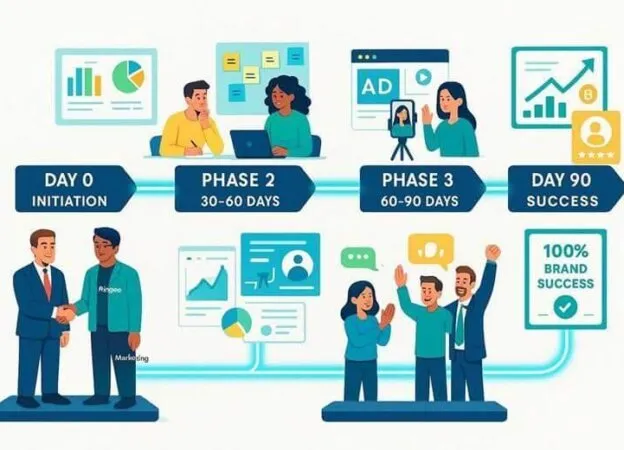In today’s fast-paced digital era, where attention spans are shorter than ever, video marketing has emerged as a formidable force for businesses eager to make their mark. With the world at our fingertips through smartphones and other devices, it’s no surprise that individuals from all walks of life spend countless hours on social media platforms and video-sharing websites. As a result, the potential reach of video marketing is now truly unparalleled. But what is it about video marketing that makes it so potent?
This article answers the question, breaking down critical strategies businesses should consider when incorporating this medium into their promotional efforts. Let’s get started.
Why Is Video Marketing So Effective?
Video marketing has become essential for any business looking to establish a solid online presence and engage with its audience.
For starters, videos possess an uncanny ability to captivate audiences, engaging both their auditory and visual senses simultaneously. This immersive experience allows viewers to absorb information more efficiently and effectively. Ultimately, videos allow companies to convey their message in a more engaging and memorable way. People tend to retain information better when presented to them in a visual format, and video marketing allows businesses to do just that.
Furthermore, videos can convey complex ideas in a simplified manner through dynamic storytelling, making them an invaluable tool for businesses seeking to promote their brand, products, and services.

Video marketing can also help companies build trust and credibility with their audience. Seeing the faces and personalities behind a brand can help humanize the business and make it feel more relatable. By creating videos that showcase your products, services, or company culture, you can help to establish a stronger connection with your audience and build brand loyalty.
Video marketing is also effective because the content has the potential to go viral. Social media platforms like YouTube, Instagram, and TikTok make it easy for videos to be shared and reach a wider audience. A compelling and engaging video can spread quickly and generate significant buzz for your brand.
It can be an effective way to boost your search engine rankings. Google and other search engines tend to favor websites with video content. By creating videos optimized for search engines, you can improve your visibility online and attract more traffic to your website.
Video marketing is most efficient when implemented by professional digital marketing agencies, such as Munro or alike. Munro is remarketing agency based in London that specializes in bringing quality leads to your business through creative and effective marketing solutions. If you want to take your video marketing to the next level and generate results that will help you grow your business, the help of a professional agency is crucial.
How Can I Use Video Content to Boost My Brand?
Now that we’ve addressed the question of why video marketing is so effective, let’s take a look at how to use video content to your advantage.
Create High-Quality Content
Successful video marketing relies on creating high-quality content that is both informative and engaging. This means investing in high-quality equipment, such as cameras and editing software, and hiring professional videographers and editors if necessary.
Businesses must strike a balance between entertainment and information. While captivating visuals and compelling narratives are essential components of any successful video campaign, companies cannot lose sight of their primary goal: promoting their brand. To achieve this delicate equilibrium, firms should create content that not only informs but also entertains and engages their target audience.
Planning and scripting your videos to effectively communicate your message is also essential. Remember, consistency is key. Establish a consistent schedule for publishing video content, as it will help you build brand recognition and foster loyalty among viewers. Moreover, maintaining a steady stream of engaging content will keep audiences coming back for more, thus increasing the overall reach and effectiveness of your video marketing endeavors.
In the era of advanced technology, there are innovative tools that can further enhance your video content creation process. Consider leveraging the power of artificial intelligence to convert text to video with AI. This cutting-edge technology allows you to transform written content into visually appealing videos and opens up new possibilities for creative and dynamic storytelling.
Keep it Short and Sweet
As consumers are bombarded with an endless stream of content each day, capturing their attention and retaining it becomes a formidable challenge. This is where the adage “less is more” rings especially true.
The key to success lies in creating videos that are concise yet impactful. Most viewers possess short attention spans and will rapidly lose interest if a video drags on for too long. Consequently, refining your content to ensure that it remains engaging throughout its duration is essential. Aiming for videos that clock in at no more than two minutes is a good rule of thumb.
However, this does not imply that one must sacrifice substance for the sake of brevity. Rather, it’s about distilling your message down to its most vital elements and presenting them in a clear, visually appealing manner. Eliminating unnecessary fluff or filler content, you can create videos that effectively deliver their intended message while being easily digestible for viewers on the go.
For example, you may begin by outlining your video’s primary objective and target audience. From there, craft a compelling narrative that quickly captures the viewer’s attention and succinctly conveys your message. Employing powerful visuals and dynamic storytelling techniques will further bolster audience engagement and retention.
Tell a Story
As highlighted previously, one of the most potent aspects of videos is their innate ability to weave a narrative that resonates with viewers on an emotional level. Harnessing the power of storytelling within your video content is essential for forging a deep connection with potential customers and fueling audience engagement.
Regardless of the subject matter — be it showcasing a groundbreaking product or service, offering a glimpse into your company’s inner workings, or sharing customer success stories — crafting a captivating narrative is crucial. A well-told story not only holds the viewer’s attention but also fosters empathy and understanding, allowing them to relate to your brand on a more profound level.
To create a compelling story within your video content, start by identifying the central message you wish to convey. This message should align with your overall marketing objectives and cater to the needs and interests of your target audience.
Next, develop a clear story arc that will guide viewers through your narrative, building anticipation and maintaining interest throughout. Incorporate relatable characters and scenarios into your storytelling, as these elements can help humanize your brand and make it more approachable. Additionally, ensure that your story has an emotional core, as this will evoke feelings in viewers and create a lasting impact.
Visuals and sound are equally important components of effective storytelling in video marketing. Employ striking visuals, creative camera angles, and high-quality audio to enhance and complement your narrative. Plus, consider using music strategically to set the tone, pace, and atmosphere of your video.

Upload Your Video Content On Multiple Platforms
To maximize the reach of your video marketing efforts, it is essential to spread your video posts across multiple platforms. This includes your website, social media platforms like Instagram and Twitter, and video-sharing websites like YouTube and Vimeo.
You need to understand the different platforms available and tailor your content accordingly. Each platform has its own unique set of features, user demographics, and algorithms; therefore, it’s essential for businesses to adapt their videos to suit the specific requirements of each platform.
By using video across various platforms, you can reach a wider audience and increase the potential for engagement.
Capitalize on User-Generated Content
In addition to creating your own videos, you can also capitalize on user-generated content (UGC). UGC is any content created by users and not directly associated with your brand — e.g., videos, photos, and reviews.
Encourage customers and fans to post videos and photos of your products or services in action. You can also run contests and giveaways to incentivize UGC. Not only will this help to increase engagement, but it can also help to build social proof and boost your brand’s credibility. Tools like Submagic further enhance this accessibility by automating subtitle creation with precision and speed. Whether you’re creating videos for social media, educational purposes, or marketing campaigns, Submagic empowers you to deliver seamless viewing experiences. Embrace the ease of automated subtitles to engage a wider audience and amplify your brand’s message effectively.
Avoid Offensive or Controversial Content
While it can be tempting to push the envelope with your video content to stand out, it is essential to remember that such an approach can be a double-edged sword.
While offensive or controversial content can boost your brand awareness, it can also backfire and damage your reputation. Therefore, it is vital to tread carefully and avoid offensive or controversial content unless you are confident that your target audience will receive it well.
Even then, avoid overdoing it. You never know when the market tides might turn, and the group you poked fun at in your videos might become the potential customers you desperately need.
Analyze and Optimize Your Results
Finally, it is crucial to analyze and optimize your video marketing efforts. By doing so, you can gauge the effectiveness of your campaigns, identify areas for improvement, and ensure that your videos generate maximum impact.
To begin this process, consistently track key metrics such as views, engagement rates (likes, comments, and shares), and conversions (leads or sales generated from the video). This data will provide valuable insights into how well your content resonates with your target audience and whether it is effectively driving desired outcomes. Once you have gathered these metrics, take the time to scrutinize them thoroughly. Identify trends or patterns that suggest what elements of your videos are working well and which aspects require refinement.
For instance, suppose a particular video has a high engagement rate but low conversion rate. In such a case, these statistics could indicate that while the content is appealing to viewers, it may not be effectively guiding them towards the desired action.
Armed with these insights, optimize your future video marketing efforts by making data-driven adjustments. It may involve tweaking the length or pacing of your videos, refining your storytelling techniques, or adjusting the call-to-action to better align with viewer expectations. Continuously testing and iterating on different elements of your videos will ultimately lead to more effective campaigns and improved results.
Conclusion
Video marketing has the power to be a highly effective tool for businesses looking to boost their brand and increase engagement with potential customers.
A significant part of its potential lies in its unparalleled ability to captivate and engage audiences on a profoundly personal level. By striking a balance between entertainment and information, telling a story, and maintaining consistency in publishing schedules, businesses can harness the true potential of video marketing to boost their brand and stand out in today’s ever-evolving digital landscape.
At the same time, creating high-quality, engaging video content and using it across multiple platforms helps companies to improve their SEO efforts, increase conversions, and boost customer retention rates.
5 Frequently Asked Questions About Video Marketing
1. Why is video marketing so effective?
The allure of video marketing lies in its ability to captivate audiences through immersive storytelling. With an ever-decreasing attention span, consumers are drawn to dynamic content that engages their senses and emotions.
Videos combine visuals, audio, and text elements to deliver a powerful message, making them more memorable and shareable than other forms of content.
2. What types of videos can I use for my brand?
The possibilities are virtually endless when it comes to video content for your brand.
You can create:
- explainer videos to educate customers about your products or services,
- testimonials showcasing success stories,
- behind-the-scenes glimpses into your company culture,
- live streams for real-time engagement,
- product demonstrations,
- and even animated films for a touch of whimsy.
The key is in understanding your target audience’s preferences and creating content that resonates with them.
3. How do I optimize my videos for search engines?
Optimizing your videos for search engines is crucial to increase visibility and drive traffic. Start by conducting keyword research to identify popular search terms related to your niche. Incorporate these keywords into your video title, description, and tags.
Additionally, create intriguing thumbnails that pique viewer interest, include captions or subtitles to cater to diverse audiences. Subtitles can make your videos more accessible to viewers with hearing impairments and also help to capture the attention of viewers who prefer to watch videos without sound. By using a subtitle editor, you can create accurate and engaging subtitles that enhance the user experience and increase the chances of your videos being discovered by a wider audience. There are multiple subtitle editor options available to you so take a look and choose the one with the features which suits you. You can also host your videos on multiple platforms like YouTube and Vimeo for maximum exposure. It is apparently easy to get more views on Vimeo and YouTube.
4. Can I repurpose my existing content into videos?
Absolutely! Repurposing existing content is an excellent way to breathe new life into your marketing efforts while maximizing resources. Transform blog posts into informative webinars or animated videos, convert customer reviews into engaging testimonials, or even turn podcast episodes into video interviews. Not only will this create fresh content for your audience, but it will also make your brand more accessible to those who prefer visual or auditory content over written text.
5. How can I measure the success of my video marketing efforts?
Tracking the performance of your videos is essential to understand their impact and refine your strategy. Key metrics include view count, watch time, engagement rate (likes, comments, shares), click-through rate (CTR) for links within the video or description, and conversion rate for leads or sales generated from the video.
Using these insights, you can fine-tune your content strategy to create videos that resonate with your target audience and drive tangible results for your brand.



